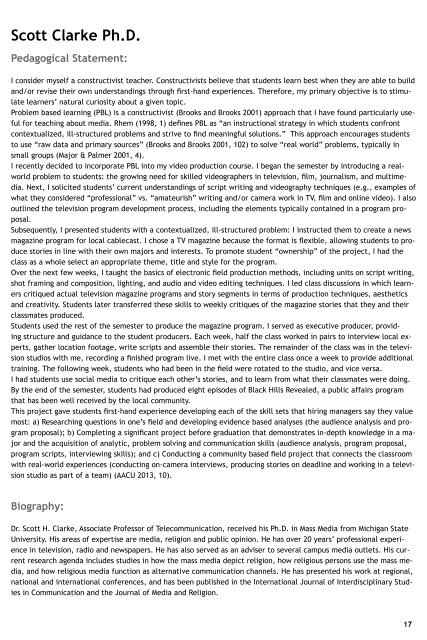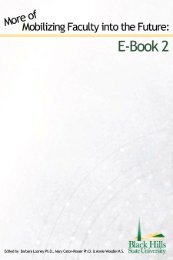Mobilizing Faculty into the Future: Using Online Technology as Teaching Tools
Create successful ePaper yourself
Turn your PDF publications into a flip-book with our unique Google optimized e-Paper software.
Scott Clarke Ph.D.<br />
Pedagogical Statement:<br />
I consider myself a constructivist teacher. Constructivists believe that students learn best when <strong>the</strong>y are able to build<br />
and/or revise <strong>the</strong>ir own understandings through first-hand experiences. Therefore, my primary objective is to stimulate<br />
learners’ natural curiosity about a given topic.<br />
Problem b<strong>as</strong>ed learning (PBL) is a constructivist (Brooks and Brooks 2001) approach that I have found particularly useful<br />
for teaching about media. Rhem (1998, 1) defines PBL <strong>as</strong> “an instructional strategy in which students confront<br />
contextualized, ill-structured problems and strive to find meaningful solutions.” This approach encourages students<br />
to use “raw data and primary sources” (Brooks and Brooks 2001, 102) to solve “real world” problems, typically in<br />
small groups (Major & Palmer 2001, 4).<br />
I recently decided to incorporate PBL <strong>into</strong> my video production course. I began <strong>the</strong> semester by introducing a realworld<br />
problem to students: <strong>the</strong> growing need for skilled videographers in television, film, journalism, and multimedia.<br />
Next, I solicited students’ current understandings of script writing and videography techniques (e.g., examples of<br />
what <strong>the</strong>y considered “professional” vs. “amateurish” writing and/or camera work in TV, film and online video). I also<br />
outlined <strong>the</strong> television program development process, including <strong>the</strong> elements typically contained in a program proposal.<br />
Subsequently, I presented students with a contextualized, ill-structured problem: I instructed <strong>the</strong>m to create a news<br />
magazine program for local cablec<strong>as</strong>t. I chose a TV magazine because <strong>the</strong> format is flexible, allowing students to produce<br />
stories in line with <strong>the</strong>ir own majors and interests. To promote student “ownership” of <strong>the</strong> project, I had <strong>the</strong><br />
cl<strong>as</strong>s <strong>as</strong> a whole select an appropriate <strong>the</strong>me, title and style for <strong>the</strong> program.<br />
Over <strong>the</strong> next few weeks, I taught <strong>the</strong> b<strong>as</strong>ics of electronic field production methods, including units on script writing,<br />
shot framing and composition, lighting, and audio and video editing techniques. I led cl<strong>as</strong>s discussions in which learners<br />
critiqued actual television magazine programs and story segments in terms of production techniques, aes<strong>the</strong>tics<br />
and creativity. Students later transferred <strong>the</strong>se skills to weekly critiques of <strong>the</strong> magazine stories that <strong>the</strong>y and <strong>the</strong>ir<br />
cl<strong>as</strong>smates produced.<br />
Students used <strong>the</strong> rest of <strong>the</strong> semester to produce <strong>the</strong> magazine program. I served <strong>as</strong> executive producer, providing<br />
structure and guidance to <strong>the</strong> student producers. Each week, half <strong>the</strong> cl<strong>as</strong>s worked in pairs to interview local experts,<br />
ga<strong>the</strong>r location footage, write scripts and <strong>as</strong>semble <strong>the</strong>ir stories. The remainder of <strong>the</strong> cl<strong>as</strong>s w<strong>as</strong> in <strong>the</strong> television<br />
studios with me, recording a finished program live. I met with <strong>the</strong> entire cl<strong>as</strong>s once a week to provide additional<br />
training. The following week, students who had been in <strong>the</strong> field were rotated to <strong>the</strong> studio, and vice versa.<br />
I had students use social media to critique each o<strong>the</strong>r’s stories, and to learn from what <strong>the</strong>ir cl<strong>as</strong>smates were doing.<br />
By <strong>the</strong> end of <strong>the</strong> semester, students had produced eight episodes of Black Hills Revealed, a public affairs program<br />
that h<strong>as</strong> been well received by <strong>the</strong> local community.<br />
This project gave students first-hand experience developing each of <strong>the</strong> skill sets that hiring managers say <strong>the</strong>y value<br />
most: a) Researching questions in one’s field and developing evidence b<strong>as</strong>ed analyses (<strong>the</strong> audience analysis and program<br />
proposal); b) Completing a significant project before graduation that demonstrates in-depth knowledge in a major<br />
and <strong>the</strong> acquisition of analytic, problem solving and communication skills (audience analysis, program proposal,<br />
program scripts, interviewing skills); and c) Conducting a community b<strong>as</strong>ed field project that connects <strong>the</strong> cl<strong>as</strong>sroom<br />
with real-world experiences (conducting on-camera interviews, producing stories on deadline and working in a television<br />
studio <strong>as</strong> part of a team) (AACU 2013, 10).<br />
Biography:<br />
Dr. Scott H. Clarke, Associate Professor of Telecommunication, received his Ph.D. in M<strong>as</strong>s Media from Michigan State<br />
University. His are<strong>as</strong> of expertise are media, religion and public opinion. He h<strong>as</strong> over 20 years’ professional experience<br />
in television, radio and newspapers. He h<strong>as</strong> also served <strong>as</strong> an adviser to several campus media outlets. His current<br />
research agenda includes studies in how <strong>the</strong> m<strong>as</strong>s media depict religion, how religious persons use <strong>the</strong> m<strong>as</strong>s media,<br />
and how religious media function <strong>as</strong> alternative communication channels. He h<strong>as</strong> presented his work at regional,<br />
national and international conferences, and h<strong>as</strong> been published in <strong>the</strong> International Journal of Interdisciplinary Studies<br />
in Communication and <strong>the</strong> Journal of Media and Religion.<br />
17






